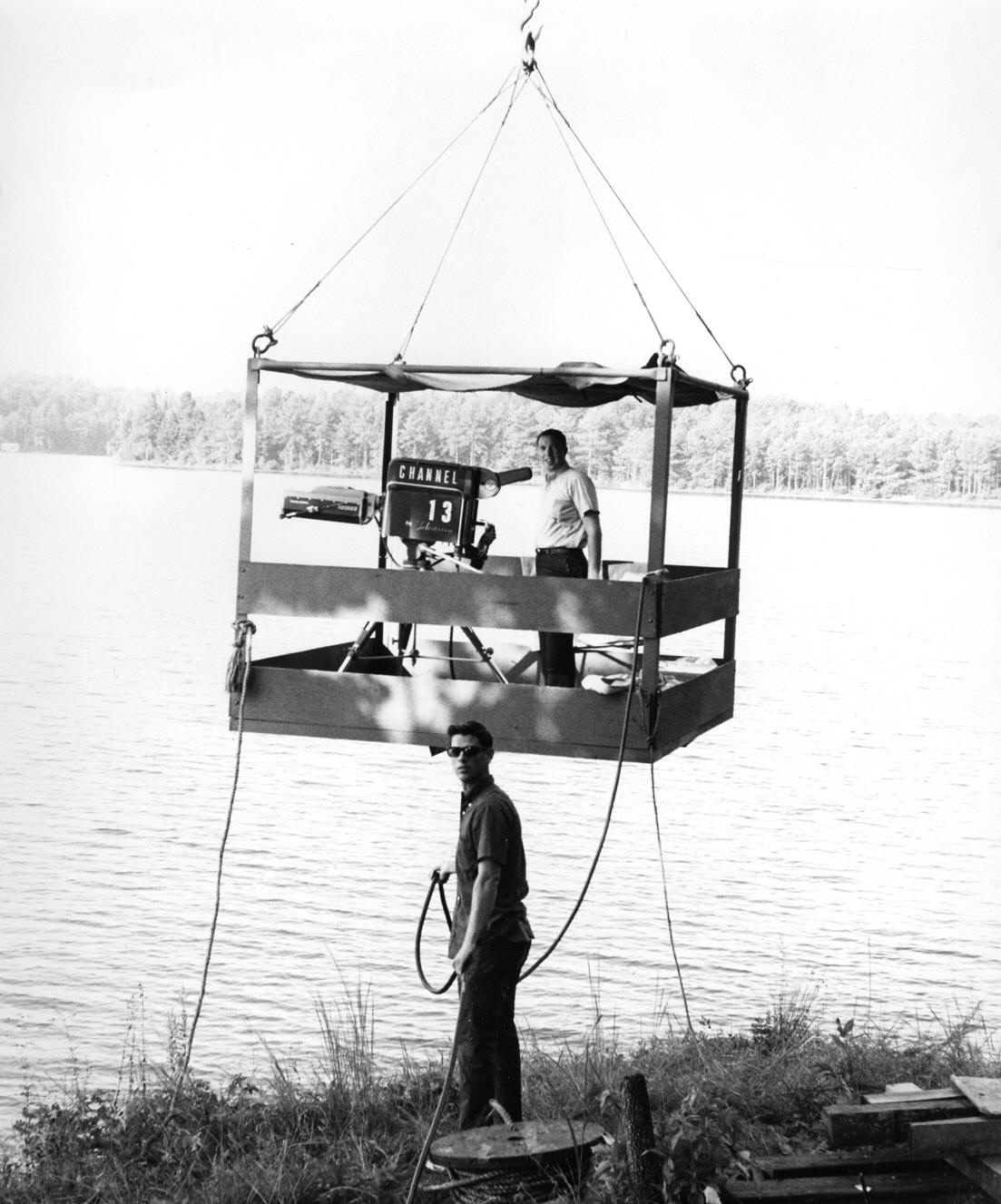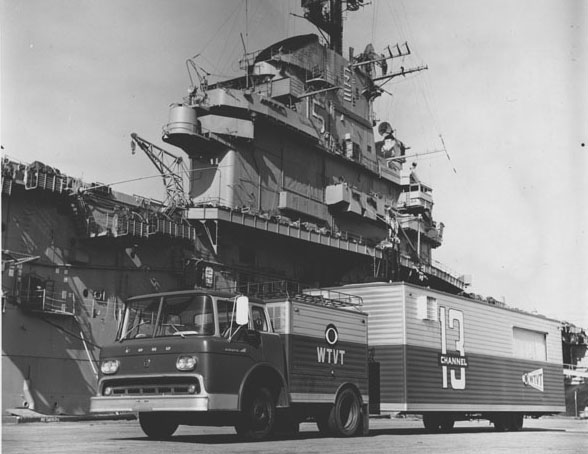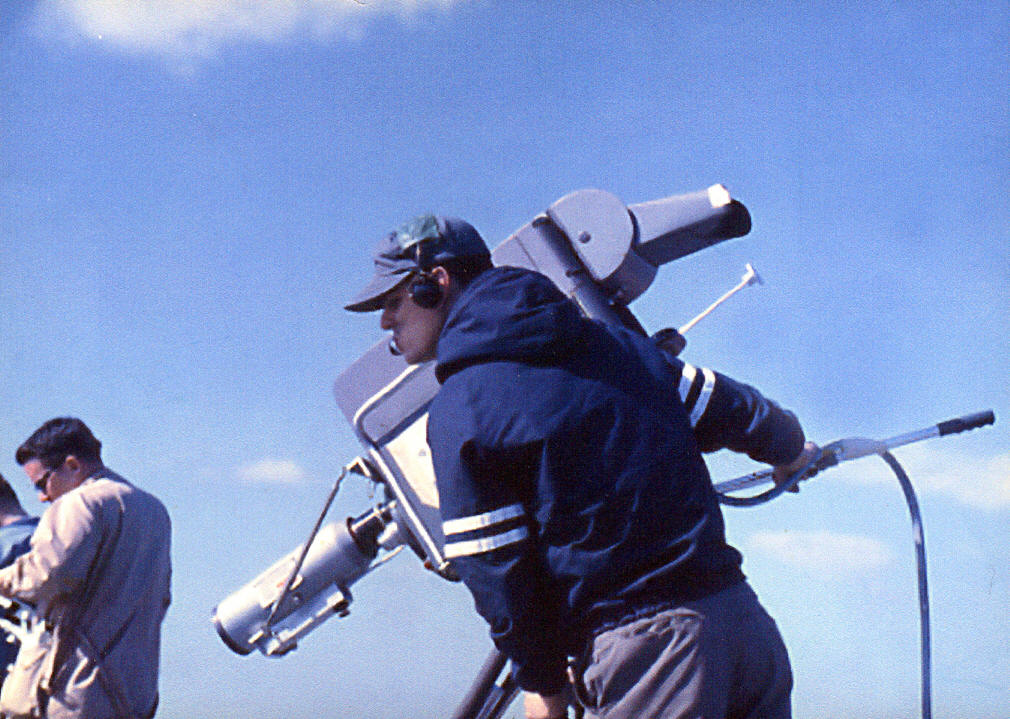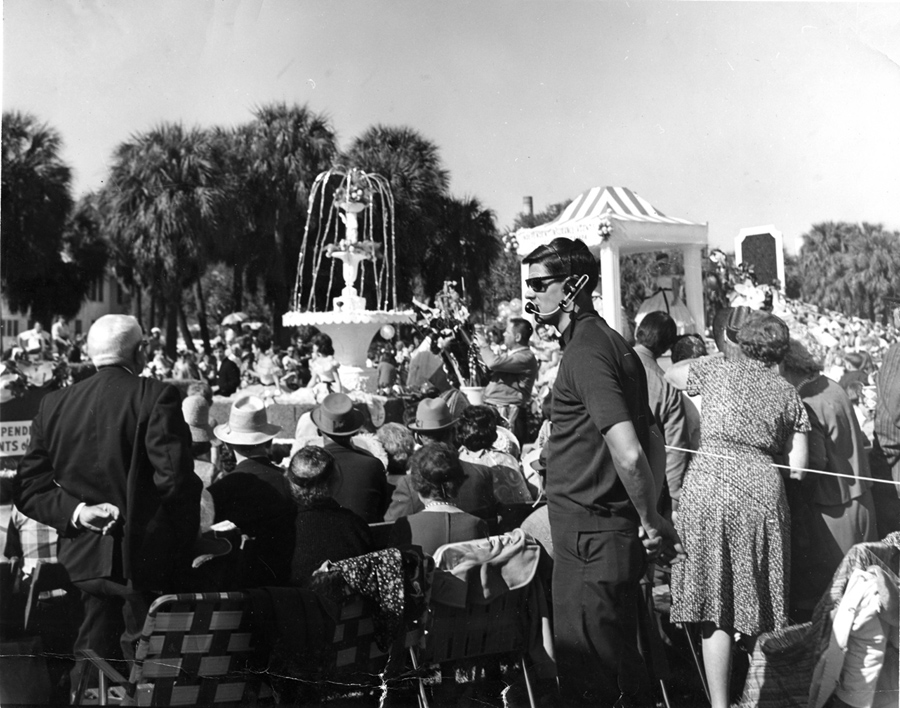|
"…PURE DUMB LUCK…"
|
Jim was still getting up to speed at WTVT when he got the opportunity to work on a remote with the station's mobile unit. "The first remote I remember doing was September of '64. It was the Lake Spivey International Motorboat Race in Atlanta. They flew the crew up to Atlanta while Ed Shaw and Jack King drove the mobile unit.

Jim on his first remote for WTVT
Jim Langham is seen above Jim in the camera enclosure
We did it for CBS. I guess I did pretty well and didn't get on Jack King's s___ list…because if you got on his list you didn't go back out there again. Jack was the engineer In charge, and the EIC were the Gods back then…you didn't mess up. You did what you were told to do. You would set up the cables the way they showed you and you didn't sit back, you did the work. I made a point of being all over the place as fast as I could doing something here and there and I really liked it. Being out of the studio in an environment you couldn't control was a real challenge to me."
Life on WTVT remotes was exhilarating but also hard work under sometimes grueling conditions. "Lake Spivey was wet, rainy, and noisy…from 7am in the morning to 7 at night…closing down restaurants because we were working late. We'd go to these 'all you can eat' places with our per diem. Jerry Prater and Doug Jones were good teachers and Jack, when he got to know you, was really great. Eddie Shaw, Woody Bell and Red McMurrow were all very helpful. In '64 we also did the governor's inauguration, and something in Georgia called "Portraits" for CBS, and remotes for the morning show at the Aquatarium on St. Pete Beach."Jim's biggest remote of that time was pool coverage for the splashdown recoveries of Gemini 6 and Gemini 7 in November of 1965. The two manned NASA capsules were scheduled to make ocean landings and it was the first time live television coverage was possible via satellite (WTVT's mobile unit had covered earlier splashdowns on videotape)

WTVT's remote unit served several
tours of duty for
the recovery of Mercury and Gemini space capsules
The
WTVT crew departed Tampa on November 26th and due to a week-long
delay in the launch of the second spacecraft, did not return until Dec. 22nd.
Jim, who had gotten seasick on his way to service duty in Germany, liked the
stability of the 900 foot-long carrier Wasp. The 'TVT crew stayed in comfy
quarters with the chief petty officer and rehearsed different scenarios of the
landings every day. There were five remote cameras in use, with Jim's camera
positioned on the flight deck with a clear shot down into
one of the
ship's massive elevators.

Jim lines up a shot for the recovery
of Gemini 6 & 7
The landing date finally arrived on December 16th
and Fred Hoedt was able to get clear pictures of the first capsule, Gemini 6,
splashing down. Jim picked up the recovery action as the capsule was
brought aboard and placed on the elevator for extracting the astronauts. Jim's camera was pointed at
an extreme down angle when the ship suddenly rolled
and he lost his grip on the zoom handle, which luckily zoomed (in focus) to a
close up of astronaut Wally Schirra as the capsule’s
hatch was being opened. "Pure dumb luck," adds Jim.
The mobile unit was converted to color in 1966 and continued to provide Tampa
Bay viewers with live events from the Florida State Fair, Tampa's Gasparilla
Parade, and St. Petersburg's Festival of States Parade.

Jim at the Gasparilla Parade

Jim operating an RCA TK-42 color camera on The Festival of States Parade
(Photo courtesy Earl Higgins)
The network remotes that included the Gemini 6 and 7 missions were certainly highlights of Jim's remote experience but it was another historical event that left him with emotional memories. "It was the funeral procession of Dr. Martin Luther King in 1968," recalls Jim. "CBS called us after Dr. King's death and said they needed our crew and mobile unit for the funeral procession ." The engineers left immediately for Atlanta with the remote truck while Jim and the Channel 13 production crew arrived via jet at 6a.m. the next day.
|
"CBS had arranged for the mobile units to cover
different parts of the march," explains Jim. "The procession
would pass from one unit to the next. I was up on
a heavy duty forklift about forty feet in the air for three or four hours. I
remember shooting telephoto down the very hilly Peach Street and saw a massive
amount of people coming towards me in the distance. They'd disappear behind one
hill and then emerge again….thousands of people. And it was quiet…very quiet.
It was very moving to see."
|
|